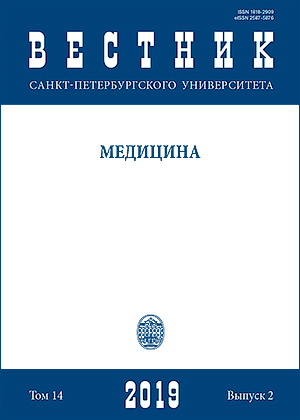Problems of diagnostics and treatment of diffuse — toxic goiter (Graves’ disease)
DOI:
https://doi.org/10.21638/spbu11.2019.202Аннотация
The article is devoted to prevalence, contemporary diagnostic methods and treatment of Grave’s disease. Advantages and disadvantages of different treatment options are discussed. The cause of the disease can be environmental conditions, infectious diseases, severe operational intervention, drugs, trauma, especially brain traumas, iodine deficiency and radiation damage of thyroid in iodine deficiency conditions, familial predisposition. The ideal treatment of Graves’ disease should ensure a fairly rapid elimination of clinical symptoms of thyrotoxicosis, return to an euthyroid state, with minimal risk of complications. The relapse rate of the disease can reach up to 80 %, using conservative treatment. The radioiodine ablation is relatively simple, non-invasive, effective and cheap. There are special indications for surgical treatment. Indications for surgical treatment: 1) large goiter (the volume of the thyroid gland is more than 45 ml); 2) frequent recurrences of thyrotoxicosis and failure of the drug and RIT; 3)malignancy of goiter; 4) allergic and toxic (leukopenic) reactions to thyreostatics. Patients with Graves’ disease should referred to a specialized center with multidisciplinary team.
Ключевые слова:
Graves’ disease, diagnostics, treatment, radical therapy, thyroidectomy
Скачивания
Библиографические ссылки
References
Загрузки
Опубликован
Как цитировать
Выпуск
Раздел
Лицензия
Статьи журнала «Вестник Санкт-Петербургского университета. Медицина» находятся в открытом доступе и распространяются в соответствии с условиями Лицензионного Договора с Санкт-Петербургским государственным университетом, который бесплатно предоставляет авторам неограниченное распространение и самостоятельное архивирование.




